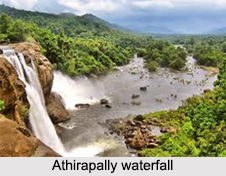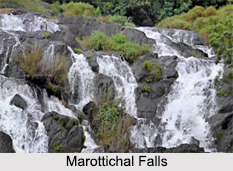 Waterfalls in Thissur are the best escapades from the maddening crowds of the city life. These waterfalls will keep a day for one who want to stay there and do nothing and also for one who love to do waterfall rappelling and other adventurous sports. Some of the waterfalls in Thissur are Athirapally waterfall, Vazhachal waterfall, Charpa fall and Marottichal Watrefalls.
Waterfalls in Thissur are the best escapades from the maddening crowds of the city life. These waterfalls will keep a day for one who want to stay there and do nothing and also for one who love to do waterfall rappelling and other adventurous sports. Some of the waterfalls in Thissur are Athirapally waterfall, Vazhachal waterfall, Charpa fall and Marottichal Watrefalls.
Athirapally waterfall
Athirapally waterfall is created by scenic hills and gurgling waters. The Sholayar basin is a joy to watch. Athirapally Falls is located about 60 kms from Thrissur town. Located on the west-flowing Chalakudy River near the Vazhachal Forest Division and the Sholayar ranges, this 24-metres waterfall and Vazhachal Falls are popular tourist destinations. Athirappilly Falls is the largest waterfall in Kerala and is nicknamed as "The Niagara of India". The forest wildlife in the area includes the Asiatic elephant, tiger, leopard, bison, sambar, and lion-tailed macaque are the habitat near the forest zone of Athirapally Falls.
Vazhachal Waterfall
 Vazhachal Falls is the second best tourist destination after Athirapally waterfall. It is located just 5 kilometers from Athirapally waterfall. It is located on the west-flowing Chalakudy River near the Vazhachal Forest Division and at the edge of the Sholayar ranges. It is located 36 km from Chalakudy.
Vazhachal Falls is the second best tourist destination after Athirapally waterfall. It is located just 5 kilometers from Athirapally waterfall. It is located on the west-flowing Chalakudy River near the Vazhachal Forest Division and at the edge of the Sholayar ranges. It is located 36 km from Chalakudy.
Charpa waterfall
Charpa waterfall is a road side waterfall near Athirapally. It will be a short break while driving from Chalakudy.
Waterfalls at Marottichal
The waterfalls at Marottichal are the tourist"s delight. One can stay in the village at Marottichal. This small village is located on the fringe of Peechi forest which can be reached by bus or car. The waterfalls are inside the forest.
Cheerankundu Kuthu and Olakkayam
Cheerankundu Kuthu and Olakkayam are located within 10 minutes walking distance from the bus stop at Marottichal. The path by the side of the canal leads there. Olakkayam is a refreshing place where one can step into the water and take a bath.
Ilanjippara
Ilanjippara is the largest waterfall in Thissur. It is just about 4 kilometers from Olakkayam. The trek through the forest takes about an hour. At Ilanjipapara, the stream flowing down as multiple patches along rock clusters. It is a remarkable sight.



















